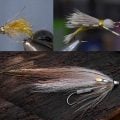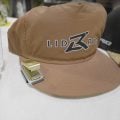How to Tie a Two-Tone Intruder
Producer: Tim Flagler
The Two-Toned Intruder is a rather easy-to-tie streamer that works especially well with trout spey gear. It’s darker back and lighter underbelly, along with just a little bit of flash, imitate a wide range of baitfish species that larger trout in particular often pursue.
The foundation of the fly is a 20mm Waddington shank. Intruder shanks will also work just fine. Begin by getting the shank firmly secured in the jaws of your tying vise, with the eye turned up. A rotary vise, although not required, makes tying this pattern much easier.
For thread, I’ve loaded a bobbin with a spool of brown UTC 140 Denier. Get your thread started on the shank, behind the eye and, after taking a few wraps rearward, snip off the excess tag. Continue taking thread wraps rearward to evenly bind the legs of the shank together, both fore and aft. End with your tying thread at the rear end of the shank.
There are many options for connecting a hook to the shank, but for trout spey intruders I really like Berkley FireLine in 30 pound test. It’s not quite wire, not quite braid, and not quite mono either, but just the right combination of strength, stiffness and flexibility. With the FireLine under tension, snip off a 6” length. Fold the length in half with the ends aligned. Insert the ends from back to front, through the eye of a size 8 intruder-style hook. Then work the loop down, over the hook bend and draw the loop tight behind the eye, like so.
Lay the FireLine against the near side of the shank at the location of your tying thread, and take a couple of wraps to lightly secure it. I like to leave a little more than a full hook length of FireLine exposed between the tie-down point and the hook eye, so the hook can be changed out, if necessary. Bind the FireLine to the top of the shank toward the eye, then tuck the ends down through the eye and begin binding them to the underside of the shank. Snip any excess off at varying lengths, then continue binding the material down. The rig should now look something like this. Relocate your tying thread to the back end of the shank.
Pick up just a small amount of superglue, here, Fly Tyer’s Z-ment and apply it to the entire shank. Try not to overdo it. Then, take tight wraps of tying thread, which will help to set the adhesive and lock everything in place.
Medium-sized, gold bead chain eyes add a little weight to the fly but mostly keep it riding correctly. Snip a 2-bead-length free from the chain. Turn the shank over so its underside faces up, then use cross wraps to begin securing the bead chain to the shank. Follow the cross wraps with a few yoke wraps, then some circular flat wraps to pull everything in. Flip the fly back to its normal orientation and take thread wraps rearward to about the 2/3 point on the shank.
Ginger-colored Angora goat is used to create a hot spot at the rear end of the fly, which will also help to keep materials from fouling with the trailing hook. Use the dubbing to make an ample 2” long noodle on your tying thread. Take wraps with the noodle to create a little ball in front of where the FireLine connects to the shank. Leave your tying thread right in front of the ball. It’s very easy to hook yourself with trailing hooks like this. Holding them back with a rubber band, so the hook point is held tight to your vise, helps to alleviate the problem.
Gold Krystal Flash is used to add a little shimmer to the pattern. Snip just 3 or 4 strands free from the hank. Fold the strands in half and get hold of the formed loop end. Advance your tying thread forward to the midpoint of the shank and begin attaching the loop there. Pull half the strands down, on either side of the shank. The dubbing ball will help to keep them separate. Snip the excess loop off close, then take a few more wraps of tying thread to make sure the ends are bound down really well. Pull the near side Krystal Flash strands back and trim them off, even with the hook point. Then do the same with the strands on the far side.
Zonked pine squirrel is used to create the darker back of the fly. Here, I’m using a skin that’s been dyed brown but still retains it’s very natural-looking fine dark markings. Snip a single, full-length Zonker free from the skin. You can see here how thin the hide is. This allows it to move very easily and it doesn’t absorb a lot of water. Make sure you’re holding the strip with the hair canted rearward, toward the back of the fly.
Align the end of the skin with the hook point then mark the spot just in front of the dubbing ball. Wet the fur to separate it at that point. Then bind the skin to the top of the shank – first with two wraps over top of it, then two around just the shank, followed by two more over top. Pull the forward-pointing portion of the strip back, out of the way, and take a few wraps in front of it. Tucking that portion of the strip back underneath the rubber band holding the hook, will help to keep it out of the way.
Mottled Golden Straw Brahma hen is used to create the lighter, underside of the fly. It, like pine squirrel, benefits greatly from natural fine dark markings, plus the texture and length of the feather’s fibers are just right for this fly. Pluck 4 – 5 large feathers free from the skin. Prep the feathers by stripping off all the lower webby fluffy fibers. Then, with the front side of the feather facing you, get hold of the its tip, and preen down the lower fibers to isolate that tip. Snip the tip off to form a small triangular tie-in anchor. Lay the anchor against the near side of the shank and take thread wraps to secure it.
Get hold of the feather’s stem with hackle pliers and bend the stem down, through the fingertips of your left hand, several times. This will help to fold the fibers rearward around the stem. Start taking wraps with the feather up the shank, preening it’s fibers rearward as you go. When you reach bare stem use your tying thread to anchor it then snip the excess off close. Repeat this feather prep and tie-in procedure with 4 or 5 more Brahma hen feathers going up the shank. The goal is to get nearly the entire shank covered with Brahma hen fibers, evenly spread out and canted rearward. Try to leave just a little bit of space behind the bead chain eyes.
Now for the fun part. Preen the Brahma hen fibers to either side of the shank, making a landing area for the pine squirrel Zonker strip. Pull the strip forward and taut then clear a small space so you can bind the strip down behind the eyes. Do this using the same wrap sequence as you used at the rear of the fly. Once the strip is bound down well, pull it up to vertical and snip it off as close as possible.
Trim away any errant or trapped fibers then take thread wraps to begin covering up the end of the Zonker strip and generally cleaning up the head area of the fly. With the head looking good, get hold of your whip finish tool and use it to do a 5 or 6 turn whip finish, seat the knot really well and snip your tying thread free. An ample coat of head cement, or here, Sally Hansen Hard as Nails, applied to the exposed thread wraps and all around the eyes, will greatly increase the fly’s durability, once it sinks in and dries.
Carefully remove the rubber band from the hook and the Two-Tone Intruder is ready to fish. Don’t be afraid to tie the pattern in different complementary color combinations.
Cast down and across, then swung or maybe stripped, it’s a fly trout find hard to resist.
How to Tie a Turbo Midge
How to Tie a Uni-Knot











